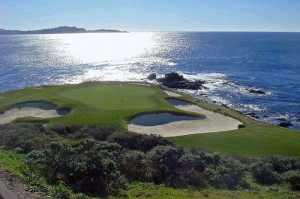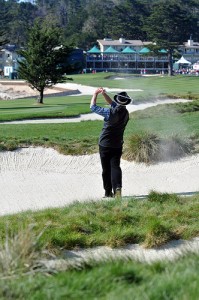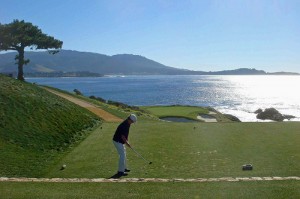 The Pebble Beach Golf Course (Pebble) is arguably the best known golf course in the world. It has more television coverage, owing to the numerous professional tournaments held there every year, than most other golf courses. The best known tournament hosted by Pebble is the original Bing Crosby National Pro Am, now called AT&T Pebble Beach National Pro Am, early in the year. Designed by Jack Neville and Douglas Grant, it opened for play in February 1919. The property was purchased by Japanese investors in the early 1990’s but was ultimately sold to Pebble Beach Co. owing to a possible criminal notoriety associated with the Japanese investors.
The Pebble Beach Golf Course (Pebble) is arguably the best known golf course in the world. It has more television coverage, owing to the numerous professional tournaments held there every year, than most other golf courses. The best known tournament hosted by Pebble is the original Bing Crosby National Pro Am, now called AT&T Pebble Beach National Pro Am, early in the year. Designed by Jack Neville and Douglas Grant, it opened for play in February 1919. The property was purchased by Japanese investors in the early 1990’s but was ultimately sold to Pebble Beach Co. owing to a possible criminal notoriety associated with the Japanese investors.
If you are like me, drifting along into your twilight years, you will likely get tons of Email entitled “Remember when…” “Remember when you could buy a bottle of coca- cola for twenty-five cents? etc., etc.” In the same vein, I thought it would be interesting to take a nostalgic visit to the Pebble Beach Golf Course in the good ‘ol days, since most golf aficionado knows the unique, picturesque features of almost every hole on the golf course.
Our one and only trip to Pebble Beach was back in 1985; when green fees were one hundred dollars per round as compared with courses like Torrey Pines that charged only fourteen dollars per round at that time. Now, in 2011, you will be paying four hundred and ninety-five dollars.
 Nestled along the southern coastline of the Monterey Peninsula, the layout of the golf course has not changed at all, except for the tweaking and grooming of the individual holes. The front nine of the golf course pretty much covers the rugged coastline along Carmel Bay, and thence, the scenic beauty and unique design of the golf course, with the seventeenth and the eighteenth holes returning to the coastline. The rest of the course, from the eleventh to the sixteenth, is inland and the scenery changes dramatically, with no hint of water around.
Nestled along the southern coastline of the Monterey Peninsula, the layout of the golf course has not changed at all, except for the tweaking and grooming of the individual holes. The front nine of the golf course pretty much covers the rugged coastline along Carmel Bay, and thence, the scenic beauty and unique design of the golf course, with the seventeenth and the eighteenth holes returning to the coastline. The rest of the course, from the eleventh to the sixteenth, is inland and the scenery changes dramatically, with no hint of water around.
Our first encounter with the uniqueness of Pebble came right in the pro shop when we went in to register and pay the green fees. 1985 was the era when all the golf courses in North America went from spiked golf shoes to “soft spikes”; that is, except for the professional tour. When we got to Pebble, however, they would not allow soft spikes; the reason being that apparently the soft spikes left round depressions on the greens that turned moldy. The pro shop made us buy rubber slipons (as in rain ware) that cost about fourteen dollars per pair (remember this is as much as playing Torrey Pines).
On the first hole, we had to join up with two Asian players that immediately impressed us with their driving skills. On each hole, they drove the ball far and straight; but after a few holes, we realized that their scores were not as good as ours. On further examination, we noted that the problem was that they couldn’t seem to hit their iron shots. Then it dawned on us that that these guys probably spent ninety-nine percent of their time on the driving range and had very little experience with hitting iron shots off the grass.
Another anecdotal note of the first hole at Pebble Beach, although this happened many years later, concerns the time Lisa Long Ball (Vlooswyk) of Calgary Alberta’s Links Ridge Golf Club visited the course. Lisa has been the world’s long drive champion for women for several years. Lisa was teamed up with her host and two strangers who made up the foursome. When Lisa proceeded to tee it up at the men’s championship (pro) tee, one of the strangers helpfully piped up, “Excuse me” he says, “the ladies’ tee is up there” pointing ahead. “That’s OK” replied Lisa, “I’ll just hit it from here”. You can guess the rest of the story…her drive was about a hundred yards ahead of everyone else’s drive!
 Our first exposure to the ocean came on the sixth hole, but most everyone will remember teeing it up on the seventh. Although measuring only ninety-seven yards (middle), when you stand there on top of the hill, looking straight down at a postage size green that looks like a hundred miles down, you immediately see why this hole receives so much television coverage. Add the prevailing strong wind off the ocean to the steep elevation change, club selection become very critical. Needless to say, several of our golf balls took a baptismal dip in Carmel Bay!
Our first exposure to the ocean came on the sixth hole, but most everyone will remember teeing it up on the seventh. Although measuring only ninety-seven yards (middle), when you stand there on top of the hill, looking straight down at a postage size green that looks like a hundred miles down, you immediately see why this hole receives so much television coverage. Add the prevailing strong wind off the ocean to the steep elevation change, club selection become very critical. Needless to say, several of our golf balls took a baptismal dip in Carmel Bay!
The next hole, the eighth, was another memorable hole. It is endlessly debated at the watering hole whether this one or the seventh hole is the signature hole of the golf course. Running parallel with the bay, your drive has to clear the hill and land somewhere on level ground at the top level. You get up to your ball and discover that there is nothing but space between your ball and the green. The area looks like a giant has taken a bite out of the land, leaving his teeth mark on a steep cliff with water down below. For me, it was a four wood shot to the green but I aimed well left of the green to shorten the chasm across the water as well as to avoid the ocean to the right of the green.
The ninth hole is relatively uneventful, that continues to run eastward along the ocean. It is a very long hole for us amateurs. The most surprising feature after completing the ninth hole was that it did not come back to the clubhouse as most golf courses do. All the club provided was a cart that sold sandwiches and pop as we motored on to the tenth hole.
The seventeenth hole brings us back to the ocean. The par three one hundred and seventy yard hole runs east to west towards the eighteenth tee box. This is a very difficult hole for us amateurs because the green is very narrow in depth but wide laterally. This is the hole where Tom Watson holed out his flop shot from just off the green to win the 1982 US Open.
The par five eighteenth hole running north along the shore is arguably the most photographed and televised hole in all of golf. The left side of the fairway drops off onto a rocky shore along the beach. Recall when Hale Irwin drove his tee shot directly over the rocks for an obvious disaster, only to have the ball bounce off the rock, land on the fairway and on his way to win the tournament. All the pros drive just past the tree on the right side of the fairway. For me, it took two good shots to get just shy of the tree and thereon took two more shots to reach the green. There were no sand traps on the left side of the green in my days, but now, you will note they keep lengthening the trap along the left side of the fairway each year.
Addendum
The owner of Pebble also owns four other golf courses in the Pebble Beach area. One of the more famous one is Spy Glass Hill Golf Course that we also played during the same trip.
While you are in this area, you would be doing yourself a disservice if you did not take the 17-Mile Drive that covers the entire perimeter of the Monterey peninsula. Apparently there is now a toll gate that goes through a gated community that we do not recall. From the north end of the peninsula at Ocean View Block, the road meanders primarily along Sunset Drive and turns inward at Cypress Point Golf Course to make a complete loop of the area.
Reflection
Should you play the Pebble Beach Golf Course, you will have created a golf memory of a lifetime. To complete this dream trip, you may wish to play the remaining courses in this area in conjunction with your drive around the 17-Mile Drive; The Links at Spanish Bay, Spyglass Hill Golf Course and the Del Monte Golf Course.
Back To California Golf Resorts
Back To Golf Resorts Digest Home Page
